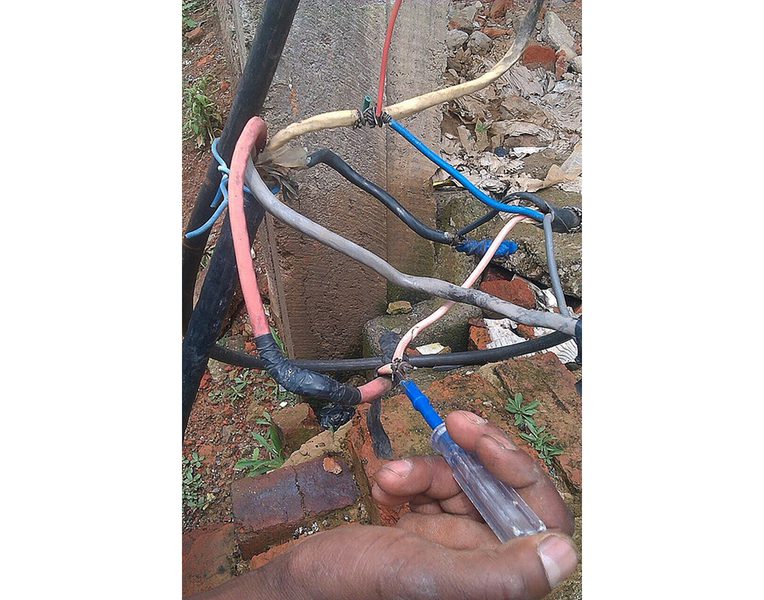Our Electric Infrastructures
From the Series: Our Lives with Electric Things
From the Series: Our Lives with Electric Things


Imagine a garage transformed into a pharmacy on the outskirts of Lubumbashi in the Democratic Republic of the Congo (DRC). It is 7 p.m., and I am reviewing my notes. In the blink of an eye all of the lights go off, marking the start of a délestage, a partial power cut initiated by the national electricity company to avoid saturation of the grid. I grab a neon screwdriver circuit tester—a voltage measuring device that relies on stray capacitance and the electrical current passing through the human body—and run toward the fuse box in the corner of the lab to test if one of the three fuses is receiving a charge. Although all of them should ideally receive 220 volts, the weak electricity grid in the DRC compels urbanites to find clever ways to manage the reduced voltage levels they receive.
Redirecting all of the wires to the one fuse that is receiving an acceptable charge has become a daily ritual for my host. An intricate web of power cables, fuse boxes, and bricolage marks the technoscape of the city. By connecting to the grid through the screwdriver, I materialize my body and emphasize the cultural polysemy of technological worlds. In this liminal state of entwinement with the electricity grid—and in a context where the social, the cultural, and the material are constantly trying to get on speaking terms to maximize the yield of the city’s infrastructure—I become aware of the amalgamation of the human and the nonhuman. In doing so, I have come to understand the possibility of fellow urbanites as infrastructure (see Simone 2004), acting as social electrons that feed the grid. By tweaking the material and relying on flows of social capital, they produce the anthropogenic energy needed to power their electric things.

In seeking to satisfy urgent power demands, many countries are investigating new, quick power-generation systems. Powerships are an increasingly popular example of such provisional energy infrastructures. Special-purpose floating power plants that plug into a national grid, powerships generate electricity from heavy fuel oil.
Currently, the only producer of powerships in the world is a Turkish company called Karadeniz Holding, which builds the ships in Istanbul and leases them to countries with high energy demands. Karadeniz refers to their projects in terms of “the power of friendship,” a campaign to bring power to those in need, and it has planned or completed projects in Ghana, Lebanon, Iraq, Indonesia, and Zambia.
Ayşegül Sultan, the first powership to arrive in Africa, accounted for 22 percent of Ghana’s total energy generation, until it was replaced by the larger powership Osman Khan in November 2017. Anchored in Ghana’s Tema Fishing Harbor, Ayşegül Sultan operated at full capacity every day to satisfy Ghana’s demand for electricity, using about one thousand tons of low-sulfur heavy fuel oil per day. Given that the ship could only hold 4300 tons of fuel, it needed to be reloaded every three to four days by a shuttle barge called Suat Bey. In a trip that took sixteen hours, this barge brought fuel from a mothership located off the coast of Lomé in Togo. Karadeniz plans to buy the mothership and move it closer to Tema to simplify future operations.
This process—the movement of fuel from the mothership to Suat Bey to Ayşegül Sultan—exposed the materiality of electricity in an unexpected way. As photographed above, Suat Bey held in its hull about one day’s electricity for all of Ghana.

I hate air conditioning in the United States—particularly in places like Washington, DC where humidity levels reach 90 percent during the height of summer. It is sticky outside, and I am melting inside. Yet I still carry a sweater with me every time I go indoors, in anticipation of the freezing temperatures I will encounter in an office building, elevator, or restaurant. The air conditioning units themselves are silent, blowing cold air, most often on overdrive, the remote control in the hands of management. Despite my layers of clothing, I feel miserable—chilled to the bone. I have come to assume air conditioning’s unwanted presence in these spaces. It is second nature.
I love air conditioning in India. In Goa, turning on the air conditioning goes along with drinking ice cold Coca-Cola out of glass bottles with a straw. Both relieve me, one from heat, another from thirst. The droning sound of the bulky window-mounted unit becomes my white noise during the premonsoon months of March, April, and May. I close the bedroom door and twist the knob one hour before going to sleep. The air conditioning unit does its job slowly. I luxuriate in it, feeling it caress my body before turning it off in anticipation of the electricity bill I will receive at month’s end. I appreciate it as a technology of atmosphere.
Air conditioning removes heat and humidity and cools interiors. It is invisible and often unnoticeable. We feel and hear it. Yet an air-conditioned place is always conditional. It makes the air we breathe no longer free to gulp down on a hot day. Instead, it is directly tied to needs and wants, of access and excess. It is a medium of comfort, a mutable infrastructure.
Simone, Abdou Maliq. 2004. “People as Infrastructure: Intersecting Fragments in Johannesburg.” Public Culture 16, no. 3: 407–429.